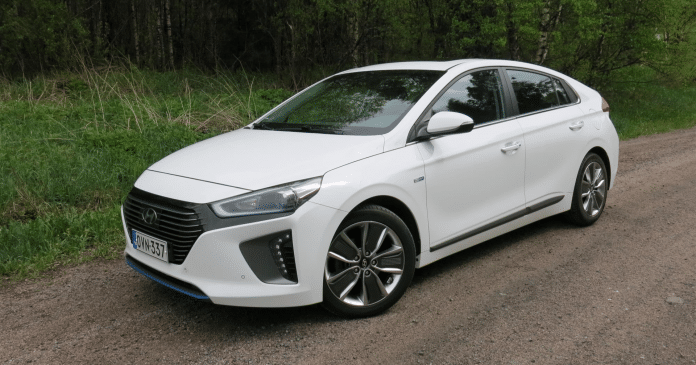Hyundai Ioniq is the first passenger car available as a hybrid, electric or rechargeable hybrid.
We tried the hybrid model of the Ioniq and overall it made a very positive impression.
When you start driving, you immediately notice a lot of positive things about the car. The seat and steering adjustments are well in place, and the lateral support of the seat is adequate. The front passenger seat is also height adjustable.
The parking brake is positively mechanical, but the hand lever on the centre console has been dispensed with and is found in the footwell in the form of a pedal. These have been seen before but the solution works, and is probably a much better solution in the long run than installing electric motors in the brake calipers.
The car’s chassis feels good, and the shock absorption is stiff but not too superficial. The weight of the car certainly helps. The car handles well in corners and the road doesn’t bother much. The steering is light, and the feel is OK. It may have been helped by the fact that the car had normal tyres underneath and not hard ecotyres.
The car’s dual-clutch automatic transmission works well. There were no extra jerks or jolts. The acceleration of the car is improved by using both engines together, but it’s no rocket ship. The manufacturer claims that the car can accelerate to 60 km/h in 10.8 seconds. Top speed is 185 km/h. However, thanks to the electric motor and a good gearbox, the car never feels unclean.
The car has a choice of sport driving mode. The normal mode is called eco mode.
In sport mode, the car keeps the revs higher and tries to keep the battery fully charged. In eco mode, the battery stays about half charged, allowing the car to make better use of the energy recovered from engine braking.
Well equipped
The test-driven version had the best equipment levels. The equipment was there both to help the driver and to improve comfort.
The car’s adaptive cruise control worked well, and during long cross-country journeys there was little need to touch the accelerator or brake. The car moved along nicely in a queue at a safe distance from the car in front.
The adaptive cruise control works better than in a Toyota CH-R hybrid, for example. The Ioniq’s safety margin is a little leeway, which means it reacts moderately and doesn’t brake suddenly if, for example, a passing car joins close in front.
If necessary, the automatic emergency braking system will also stop the car.
If the car is drifting out of its lane or over the kerb without using its indicators, the lane departure warning system sounds an audible alarm and corrects the steering if necessary.
However, the Lane Departure Warning system leaves a lot of room for improvement. When driving in the middle lane on a normal road, the car almost constantly makes small corrective movements which are felt by the steering as small but annoying jerks. A better working system would be nice to have on, now it was mostly off.
The car felt quite quiet, and the interior surfaces gave a quality feel.
The car starts silently, unless you press the accelerator to the floor. When driving slowly, the car is propelled forward by an electric motor. Only very short stretches can be driven on electric power alone, but the car can go for stretches on pure electric power even at highway speeds.
Two 12-volt electrical sockets are available for the front passengers. There are also a couple of usb sockets.
The car’s media and navigation system has an 8-inch screen and is compatible with Android Auto and Apple Carplay.
In hot weather, the car’s sunroof was a delight, as were the ventilated leather front seats. The ventilation was so strong, however, that even at the lowest power level it felt as if the seat quickly became too cold.
Suitable for family use
The car has the feel of a normal family car, and the hybrid function is by no means emphasised.
There is good legroom for passengers in the back of the car, with a boot capacity of 443 litres under the hat rack and 1 505 litres with the rear seat backs folded. The rear seat can be split 60:40.
The Hyundai Ioniq Hybrid was a major challenger to the Toyota Prius when it was launched. But now there are more hybrids on offer and the competition is heating up.
the 1.6-litre internal combustion engine produces 105 horsepower, with additional power coming from a 44-horsepower electric motor. In total, 141 horsepower is available.
Switching between the electric and internal combustion engine is completely seamless. The only way to keep track of which engine is running and whether the battery is charging or discharging is to follow the diagram on the screen.
The battery pack has a capacity of 1.6 kilowatt-hours and is located under the rear seat. This way it does not reduce the boot space. The battery is made with lithium-ion polymer technology.
Hyundai promises an average fuel consumption of around 3.3 litres per 100 kilometres for the Ioniq hybrid. This figure was not achieved, but after 500 kilometres on the road, the car’s odometer showed an average consumption of 4.2 litres per 100 km. With narrower front tyres, there should be no problem getting well below 4 litres. Even in hard driving, the average consumption did not rise much above 5 litres per 100 km.
Hyundai offers a 5 year unlimited mileage warranty on the Ioniq model, plus an 8 year / 200,000 km warranty on the high voltage batteries.
The basic version of the car costs €27 590, while the test-driven model costs €31 590 without options.





